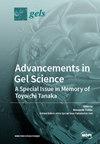Effect of Tannic Acid Concentrations on Temperature-Sensitive Sol-Gel Transition and Stability of Tannic Acid/Pluronic F127 Composite Hydrogels.
IF 5
3区 化学
Q1 POLYMER SCIENCE
引用次数: 0
Abstract
Recently, interest in polyphenol-containing composite adhesives for various biomedical applications has been growing. Tannic acid (TA) is a polyphenolic compound with advantageous properties, including antioxidant and antimicrobial properties. Additionally, TA contains multiple hydroxyl groups that exhibit biological activity by forming hydrogen bonds with proteins and biomacromolecules. Furthermore, TA-containing polymer composites exhibit excellent tissue adhesion properties. In this study, the gelation behavior and adhesion forces of TA/Pluronic F127 (TA/PluF) composite hydrogels were investigated by varying the TA and PluF concentrations. PluF (above 16 wt%) alone showed temperature-responsive gelation behavior because of the closely packed micelle aggregates. After the addition of a small amount of TA, the TA/PluF hydrogels showed thermosensitive behavior similar to that of PluF hydrogels. However, the TA/PluF hydrogels containing more than 10 wt% TA completely suppressed the thermo-responsive gelation kinetics of PluF, which may have been due to the hydrogen bonds between TA and PluF. In addition, TA/PluF hydrogels with 40 wt% TA showed excellent tissue adhesion properties and bursting pressure in porcine intestinal tissues. These results are expected to aid in understanding the use of mixtures of TA and thermosensitive block copolymers to fabricate adhesive hydrogels for versatile biomedical applications.单宁酸浓度对温度敏感性溶胶-凝胶转变及单宁酸/丙酮 F127 复合水凝胶稳定性的影响
最近,人们对用于各种生物医学应用的含多酚复合粘合剂的兴趣与日俱增。单宁酸(TA)是一种多酚化合物,具有抗氧化和抗菌等优点。此外,单宁酸含有多个羟基,可与蛋白质和生物大分子形成氢键,从而表现出生物活性。此外,含 TA 的聚合物复合材料还具有出色的组织粘附性能。本研究通过改变 TA 和 PluF 的浓度,研究了 TA/Pluronic F127(TA/PluF)复合水凝胶的凝胶行为和粘附力。单独使用 PluF(高于 16 wt%)时,由于胶束聚集紧密,会出现温度响应性凝胶行为。添加少量 TA 后,TA/PluF 水凝胶显示出与 PluF 水凝胶类似的热敏行为。然而,TA/PluF水凝胶中TA的含量超过10 wt%时,完全抑制了PluF的热响应凝胶化动力学,这可能是由于TA和PluF之间的氢键所致。此外,含40 wt% TA的TA/PluF水凝胶在猪肠组织中表现出优异的组织粘附性能和爆裂压力。这些结果有望帮助人们了解如何使用 TA 和热敏嵌段共聚物的混合物来制造粘合性水凝胶,以用于多种生物医学应用。
本文章由计算机程序翻译,如有差异,请以英文原文为准。
求助全文
约1分钟内获得全文
求助全文

 求助内容:
求助内容: 应助结果提醒方式:
应助结果提醒方式:


